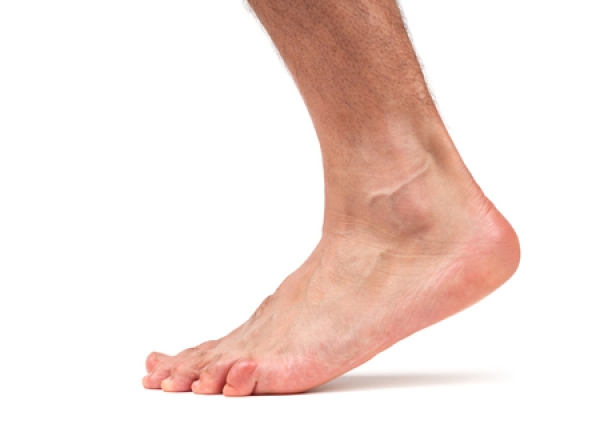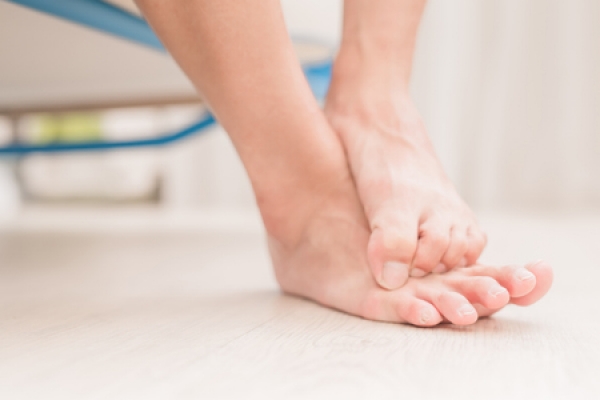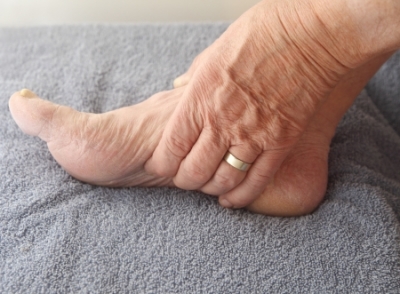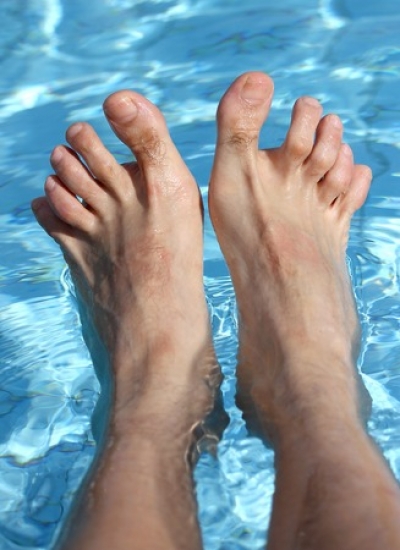Connect With Us
Blogs

Common Foot Conditions (4)
At Superior Foot & Ankle Care Center we treat many patients with flat feet. This common condition can be a source of ongoing pain and also cause swelling and a lack of flexibility in the foot. Oftentimes, people with flat feet also suffer from heel pain due to the biomechanical dysfunction that alters the structure and motion of the foot.
In some people, flattening of the arch begins during adolescence and continues into adulthood. For others, it is caused by Posterior Tibial Tendon Dysfunction or PTTD—a condition that has to do with changes in this tendon that provides major support for the arch of your foot. Other contributing factors to flat feet include:
- Genetics
- Weight gain
- Injury or trauma
- Aging
- Arthritis
Getting Relief
Our podiatrists, Dr. Victoria M. Foley or Dr. Constance Ornelas will want to examine your feet and determine the source of the your deformity. If your fallen arches are not causing you pain, the foot doctor may just take a wait and see approach and monitor your condition. Flat feet is usually a progressive disorder and therefore is best treated sooner rather than later. Regardless of the cause, however, there are several non-invasive treatment options available. These include:
- Icing the painful area
- Anti-inflammatory medications
- Physical therapy
- Arch supports, braces or supportive tape
- Custom orthotics
- Rest
- Choosing more supportive shoes
When these measures fail to bring relief or the arch continues to fall, surgery may become necessary. We offer flat foot reconstruction surgery that can provide a long-term correction of your fallen arches. If you are suffering with painful flat feet, contact our Long Beach office as soon as possible by calling: (562) 420-9800. The podiatrist will discuss the best surgical option for your specific case of flat feet and let you know what you can expect as far as results and recovery time.
At Superior Foot & Ankle Care Center, we urge all of our patients to inspect their feet regularly and report any unusual changes to our podiatrists, Dr. Victoria Foley or Dr. Constance Ornelas. Sometimes, however, we find out that patients put off making an appointment at our Long Beach office because the change they’ve noticed just doesn’t seem that serious. Small changes can mean big foot problems, and your feet can also act an “early warning system” for diseases that can affect your whole body. Below are some changes in your feet and what they may mean:
- Red skin. Although short-term redness of the feet could just be due to temperature change or an allergic reaction to your laundry detergent, consistent redness can mean something more serious. Infections, such as athlete’s foot, can start with redness of the skin and an itchy rash. Consistently red or inflamed feet can also be a sign of the autoimmune disease of lupus.
- Black toenail. Unless you’ve recently stubbed your toe or you’re a runner, a black or discolored toenail is characteristic of a fungal infection. These may not be painful initially but will continue to progress and are contagious if not treated.
- There are several diseases which can cause excess fluid buildup (also called edema) in your legs and feet. These include: kidney or liver failure, heart disease and diabetes. If you are pregnant, a certain amount of swelling is normal but if in the last trimester of your pregnancy you experience sudden or excessive swelling, it may be a sign of a preeclampsia, a serious condition that requires immediate treatment.
- Cold feet. If your feet are always cold, regardless of the season or temperature, it can be an indicator of poor circulation. There are several possible causes for this, including diabetes, anemia and an underactive thyroid.
- Everyone gets a foot cramp occasionally, but if you are getting them regularly, it’s something to get checked out. In some cases, it may simply be a case of dehydration or a lack of certain minerals in your diet like magnesium, potassium or calcium. On the other end of the spectrum, however, ongoing foot cramps can be an indicator of nerve damage.
If you notice anything different about your feet or ankles—even if the changes are not painful or dramatic—contact us as soon as possible at: (562) 420-9800.
May is National Osteoporosis Month and at Superior Foot & Ankle Care Center we want to offer 52 reasons—all the bones in your feet–why you should be concerned about this disease. Patients with osteoporosis make too little bone, lose too much bone or both. The end result is weakened bones that are more likely to fracture. Many people are unaware that they even have osteoporosis. In fact, when our podiatrists, Dr. Victoria Foley and Dr. Constance Omelas diagnose a stress fracture in the foot it is often then osteoporosis is discovered.
Know Your Risk
Osteoporosis affects half of all adults over the age of 50. One in four men and one in two women will break a bone in their lifetime as a result of osteoporosis. For women, that incidence is higher than the risk of heart attack, stroke and breast cancer combined! Factors that put you at greater risk include:
- Early menopause
- A family history of osteoporosis or frequent fractures
- Body type—thin, small people are more likely to suffer from osteoporosis
Build Stronger Bones
Fortunately, there are ways you can greatly reduce your risk of osteoporosis and future fractures:
- Start by talking to the foot doctor about your risk, particularly if you have already broken a bone in your foot or ankle. The podiatrist can refer you to testing and medical professionals that can help assess your risk.
- Up your intake of calcium and vitamin D. You can do this by including more dairy products or those fortified with calcium and vitamin D (juices and cereals, for example) in your diet. You can also add more leafy greens and fatty fish, such as salmon and mackerel and other non-dairy foods that are rich in calcium to your meals. Supplements are also available.
- Make exercising regularly a priority. Both weight-bearing and muscle-strengthening exercises should be part of your fitness routine if you want to build and maintain bone strength in your feet, ankles and the rest of your body.
- Don’t smoke or drink alcohol in excess—these are both known to weaken bones and also lead to nutritional deficits which can further decrease bone mass.
Take measures now to ensure that you can keep taking steps and living an active life for many years to come. If you have questions about the health of your foot and ankle bones, contact our Long Beach office by calling: (562) 420-9800.
At Superior Foot & Ankle Care Center we often find that patients have no trouble identifying a hammertoe—its telltale downward bent at the joint makes it fairly obvious—but often that’s where the knowledge stops. Too often patients suffer for a long time with a hammertoe because they do not fully understand the condition and their treatment options. Below some common myths about hammertoes are dispelled to help patients be more informed about this condition:
MYTH: Hammertoes are caused by shoes that are too tight.
TRUTH: It’s true that improperly fitting shoes can contribute to or exacerbate the condition of hammertoe but usually a muscle/tendon imbalance predisposes the toe to bend downward. In some cases, one toe is longer than the others and pushes up against the front of the shoe. Hammertoe can also be genetic, the result of arthritis or a neurological or structural issue.
MYTH: It’s possible that over time hammertoes will get better without treatment.
TRUTH: Hammertoes are a progressive condition. Although they may progress at varying rates they will not improve and will, in fact, worsen to the point of being disabling if not treated. It’s important to have one of our podiatrists, Dr. Victoria Foley and Dr. Constance Omelas examine your hammertoe to assess how far it has progressed. The foot doctor may order x-rays to get a better look at the current state of the joint and will also want to get a complete medical history. Hammertoes should be monitored by the podiatrist.
MYTH: There’s no real treatment for hammertoes.
TRUTH: Actually there are several conservative options available to the foot doctor to help decrease pain, increase comfort and slow the progression of a hammertoe. These include: strapping or taping the toe to establish realignment, using a custom orthotic device to correct or compensate for a muscle tendon imbalance and doing stretching and other exercises to increase flexibility and strengthen supporting muscles. In addition, patients should choose shoes with low heels that have roomy toe boxes and are made of soft materials to avoid further stress to the toe and irritations such as corns, calluses, and ulcers from developing. If none of these treatments are successful or there are other deformities such as bunions in addition to the hammertoe the foot doctor may recommend surgery to correct the problem.
You have options so don’t suffer needlessly. If you have a hammertoe contact us for an appointment at our Long Beach office today by calling: 562-420-9800.




